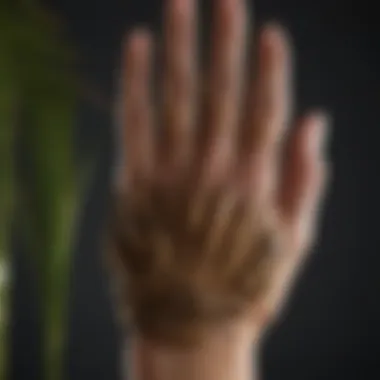Unlocking Secrets: An In-Depth Guide to Palm Reading


Intro
Palm reading, or palmistry, is an ancient practice intertwined with various cultures throughout history. It serves as a unique approach to personal insight and reflection, analyzing the lines, shapes, and mounts present on one's palm. Each feature offers a glimpse into personality traits, potential futures, and emotional landscapes. Understanding these elements can thus enhance one's comprehension of self and the world around them.
By delving into palm reading, individuals access an intricate language that conveys rich narratives captured within their hands. This article seeks to empower readers with fundamental knowledge and insights into the art of palmistry. From examining the historical origins to contemporary interpretations, readers will gain a comprehensive grasp of this fascinating discipline.
Understanding the Zodiac
Overview of Zodiac Signs
The Zodiac system comprises twelve distinctive signs, each representing various character traits and life tendencies. These signs derive from the position of celestial bodies at the time of one's birth. The signs are Aries, Taurus, Gemini, Cancer, Leo, Virgo, Libra, Scorpio, Sagittarius, Capricorn, Aquarius, and Pisces.
Sign Traits and Characteristics
Each Zodiac sign carries unique characteristics that inform behaviors and preferences. For instance:
- Aries is often seen as assertive and energetic.
- Taurus tends to be practical and reliable.
- Gemini individuals are known for their adaptability and sociability.
Knowing these traits can aid palmists in interpreting hand features, as a person’s sun sign often correlates with certain characteristics manifested in their palm.
Elemental Qualities
The Zodiac signs can also be categorized into four elemental groups:
- Fire (Aries, Leo, Sagittarius)
- Earth (Taurus, Virgo, Capricorn)
- Air (Gemini, Libra, Aquarius)
- Water (Cancer, Scorpio, Pisces)
These elemental qualities further deepen the understanding of personality types within palmistry. For example, Fire signs often display dynamic lines, indicating passion and impulsivity, while Earth signs show grounded features, denoting practicality.
Understanding these components can enhance analyses in palm reading, providing richer insights into an individual’s life path and personality.
Astrological Insights
Current Astrological Trends
Astrology is fluid, with shifting trends impacting personal and collective experiences. Observing these shifts can aid palmists in their interpretations. Keeping abreast of current astrological movements allows practitioners to contextualize readings within broader cosmic influences.
Influence of Celestial Events
Eclipses, retrogrades, and planetary alignments all bear significance in astrology. These celestial events affect human experience, and understanding them can enhance palmistry readings. For example, a Mercury retrograde might indicate introspection, which could manifest in certain line changes in the palm.
How to Interpret Your Birth Chart
A birth chart, detailing the position of celestial bodies at birth, is vital for comprehensive astrological insights. Palmists can draw parallels between a person’s birth chart and their palm features, leading to deeper interpretations of life patterns and potentials.
Horoscope and Predictions
Monthly or Weekly Forecasts
Horoscopes provide personalized insights into one’s upcoming experiences. They can be useful for palmists as they form specific predictions based on current planetary movements and individual birth charts.
Personalized Horoscope Reading
Crafting a horoscope is a meticulous process, requiring knowledge of astrological placements. By aligning palm features with horoscope readings, practitioners can offer more tailored insights, enhancing personal growth and self-understanding.
Compatibility Readings based on Zodiac signs
Analyzing compatibility between different Zodiac signs allows for more profound relational insights. Understanding how these traits impact interpersonal dynamics can inform palm readings, making them more relevant and meaningful.


Prolusion to Palm Reading
Palm reading, also known as palmistry, is a fascinating art that has intrigued humanity for centuries. It serves as both an ancient practice and a contemporary tool of self-exploration. Understanding palm reading involves much more than merely looking at one's hand; it is about interpreting intricate details that can offer insights into personality, life experiences, and future possibilities.
Understanding Palmistry
Palmistry stands out due to its unique blend of art and science. It encompasses various aspects, including the lines, mounts, and shapes of the hand. Each component holds distinct significance, revealing different dimensions of a person’s character and life path. For instance, the heart line may reflect emotional tendencies, while the head line can indicate intellectual attributes. This intricate system makes palm reading both a personal journey and a meditative practice for both the reader and the subject.
Historical Context of Palm Reading
The roots of palmistry trace back thousands of years, with origins found in ancient civilizations such as India, China, and Greece. The oldest known texts on this subject date back to the Vedic texts around 4000 BC, showcasing its historical significance. Over time, palmistry transcended cultural boundaries, gaining popularity in various forms worldwide. Noteworthy figures, such as Aristotle, engaged with palmistic ideas, further embedding palm reading into the fabric of philosophical and esoteric discourse.
Understanding the historical context of palm reading enhances one’s appreciation of its complex nature. It highlights how the interpretations of lines and shapes have evolved, influenced by different cultures and eras. As such, grasping these fundamentals can enrich one’s practice, revealing underlying patterns that resonate across time.
"Palmistry is a mirror reflecting the tumultuous nature of human life, revealing that what is etched on the palm is but a fragment of the greater narrative of existence."
This introduction sets the stage for delving deeper into palm anatomy, interpreting the various elements related to this ancient art, and further understanding its practical applications. As readers progress through this guide, they will find that palm reading is not merely a superficial activity but a meaningful exploration of self and others.
The Basics of Palm Anatomy
Understanding the anatomy of the palm is foundational for anyone interested in palmistry. This section will explore the significant features that contribute to palm readings, allowing for a deeper comprehension of personality traits and life experiences. The structure and characteristics of the palm can reveal much about an individual. This knowledge not only enhances the reading experience but also aids in self-discovery for those who seek insight.
Major Lines of the Palm
Heart Line
The Heart Line resides at the top of the palm and is essential for interpreting emotional states and relationships. It reflects feelings, affections, and emotional responses. This line’s curve and length can indicate the nature of a person’s emotional life. For instance, a long and deep Heart Line often suggests an abundance of emotional wisdom. Readers frequently focus on this line first, as it represents love and emotional fulfillment. However, an overly curved line might signify emotional turbulence or a tendency toward idealism.
Head Line
The Head Line runs below the Heart Line and represents intellect, thought processes, and decision-making. Its length can denote the scope of intellectual pursuits and the clarity of thought. A longer Head Line is often associated with a rational thinker, while a short line may indicate a more spontaneous or intuitive approach. This line helps in understanding cognitive tendencies and problem-solving skills, making it a critical aspect of palmistry analysis. Furthermore, a wavy Head Line could suggest inconsistency in thinking or indecisiveness.
Life Line
The Life Line is typically arched around the base of the thumb and is often misconstrued as an indicator of lifespan. Instead, it reveals the overall vitality and health of the individual. Its depth and clarity often imply a robust constitution and zest for life. Conversely, a faint Life Line may indicate low energy or a life marked by challenges. Importantly, the shape and positioning can inform about significant life changes and resilience, making it a pivotal line in palm readings.
Minor Lines and Their Significance
Fate Line
The Fate Line, not present in every individual, offers insight into life’s journey and destiny. This line may suggest how one navigates life’s ups and downs based on external influences. Its visibility can show the strength of external factors affecting personal development. A strong Fate Line often indicates a clear sense of purpose, while interruptions in the line could suggest changes or obstacles in one's career or personal path.
Sunal Line
Less commonly known, the Sunal Line reflects creativity and general well-being. It is often related to artistic flair and how one expresses themselves. Although not universally recognized in palm readings, when present, it can indicate a strong personal narrative shaped by creative endeavors. The presence of this line can show the potential for personal growth through creative expression, highlighting its significance in understanding one's character.
Mounts of the Palm
Mount of Venus
The Mount of Venus, located at the base of the thumb, signifies love, compassion, and sensuality. This mount's fullness can indicate warmth and strong personal relationships. An elevated Mount of Venus suggests a passionate nature, while a flat mount may imply emotional restraint. Thus, it becomes vital in assessing one's approach to intimacy and relationships.
Mount of Jupiter
Positioned just under the index finger, the Mount of Jupiter represents ambition and confidence. A prominent mount denotes a strong drive and leadership qualities, providing insight into one’s aspirations and self-esteem. This mount plays a role in revealing how a person perceives authority and positions of power, making it a valuable part of palmistry.
Mount of Saturn


The Mount of Saturn is found beneath the middle finger and is tied to responsibility and discipline. This mount's prominence can denote a serious demeanor and a strong work ethic. When the mount is well-developed, it suggests the ability to handle life's challenges with a pragmatic approach. This area contributes to understanding a person’s sense of duty and their ability to remain grounded.
Understanding these fundamental aspects of palm anatomy allows for a more accurate interpretation of palmistry. Each line and mount provides integral information for both the reader and the individual seeking insight.
Techniques for Palm Reading
Understanding the techniques of palm reading is essential for both novices and seasoned practitioners alike. These techniques dictate how effective a reading can be by ensuring a clear interpretation of the hand's features. Proper technique lays the foundation for accurate readings, encompassing everything from preparation to executing the reading itself.
Preparation for Reading
Preparation is more than just physical readiness. It involves creating a conducive environment that promotes focus and calm. Start by ensuring good lighting and a quiet space free of distractions. You may also want to have materials handy, like a notebook for observations and perhaps a guide on palmistry for reference.
Besides the physical space, mental clarity is important. Engage in a brief mindfulness exercise or deep breathing. This helps sharpen your focus and attune your intuition to the energies present. Understanding the specific context of the reading—whether it is for self-discovery or offering insights to another person—can also guide your approach.
How to Hold the Hand
The way you hold the hand can influence the reading's effectiveness. The preferred method involves gently cradling the hand in your palm while allowing it to rest comfortably. Be mindful of your grip; it should not feel restrictive. The dominant hand is often read first, as it is said to reflect current traits and life events, while the non-dominant hand typically reveals potential and inherited traits.
Positioning is also key. Hold the hand so that the palm faces upward, allowing for a clear view of the lines and mounts. Take notice of how the individual feels about their own hand. Is there tension? Comfort? These emotions can affect the reading and should be acknowledged.
Interpreting Lines
The lines on the palm convey stories of one’s life experiences and personality traits. Each line has its own unique significance. The heart line often speaks to emotional states and relationships. The head line reveals intellectual capacities and thought processes. The life line, contrary to popular belief, does not predict lifespan but rather represents vitality and life changes.
When interpreting the lines, look for clarity, depth, and curvature. A deep line generally signifies a strong influence in that area, while a faint line suggests a lesser significance. Also, pay attention to breaks, forks, and other markings which may indicate significant changes or events.
Understanding the nature of the lines provides a key to unlocking deeper insights into one's character and potential.
Account for the context in which you are reading as well. A reading conducted during a candid conversation may yield different insights than one rooted in a formal setting. It is essential to integrate both intuition and analytical skills to understand the dynamic nature of palmistry fully.
Understanding Personality Traits through Palmistry
Understanding personality traits through palmistry is a crucial aspect of this ancient practice. Palmistry offers insights not only into an individual's emotional makeup but also their potential strengths and weaknesses. By examining the various elements of the hand, practitioners can gain a better understanding of personality dynamics.
Link between Hand Shape and Personality
The shape of a person's hand can reveal significant information about their character. Each type of hand shape corresponds to one of the classical elements: earth, air, fire, or water. By determining the dominant shape, insights can be drawn about basic traits and tendencies.
Elemental Hand Shapes
Elemental hand shapes play a vital role in understanding personality traits. The broad categories include:
- Earth Hands: Square palms and short fingers indicate practicality and reliability.
- Air Hands: Square palms and long fingers reflect intelligence and communication skills.
- Fire Hands: Rectangular palms and short fingers signify passion and creativity.
- Water Hands: Rectangular palms and long fingers denote emotional sensitivity and intuition.
Understanding these shapes can be beneficial in assessing how an individual interacts with their environment. For instance, someone with earth hands may approach life with a grounded perspective, while a person with air hands might excel in social settings. However, one must consider that these traits can manifest variably among individuals.
Influence of Finger Length
Finger length also has significance in palmistry. The proportions of fingers can offer insights into how individuals process information and interact with others. Key points to note include:
- Long index fingers: These often indicate leadership qualities and ambition.
- Short index fingers: These may suggest a more relaxed approach to life and lower assertiveness.
- Long ring fingers: These can point to creativity and openness to new experiences.
- Short ring fingers: These may reflect practicality and a focus on tangible outcomes.
The influence of finger length is popular among palmists because it can guide interpretations about decision-making styles and relational dynamics. However, it is essential to remember that, similar to hand shapes, no single aspect can fully define a person's personality.
Reading Character through Fingerprints
Fingerprints are unique to each individual and can serve as an additional layer in the analysis of personality. They reveal specific details about character traits and may even indicate tendencies regarding career paths and interpersonal relationships. By examining the patterns, whether they be loops, whorls, or arches, one can infer aspects of behavior and predispositions.


Practical Applications of Palm Reading
The practice of palm reading has transcended its traditional roots, offering valuable insights into contemporary life. Practical applications of palmistry extend beyond mere curiosity. They encompass pathways for self-discovery, interpersonal communication, and therapeutic practices. The ability to interpret palm lines and features can foster greater understanding of oneself and others. As such, this section illuminates the significant elements of palm reading that provide real benefits.
Self-Discovery and Reflection
Engaging in palmistry allows individuals to embark on a journey of self-exploration and personal growth. It invites introspection on many levels. A person can analyze their major lines and mounts to gain insights into their emotional tendencies, thought processes, and life choices. Here are some potential benefits of using palm reading for self-discovery:
- Enhanced self-awareness: By understanding the symbolism of the lines, individuals can identify patterns in their behavior. This leads to a better grasp of their strengths and weaknesses.
- Goal setting: Palmistry may help clarify aspirations. For example, someone looking at their fate line may consider whether their current path aligns with their true desires.
- Understanding relationships: Reflection on palm traits can offer clues about how individuals relate to others, enhancing empathy and connection.
Overall, palm reading serves as a tool for profound reflection on one’s life journey, facilitating meaningful choices and growth over time.
Using Palmistry in Counseling
In a counseling context, the insights gleaned from palm reading can be integrated into therapeutic practices. It can foster conversations and nurture client-therapist relationships. Here are some thoughts on integrating palmistry into counseling:
- Facilitating dialogue: Discussion of palm features can help clients articulate feelings they may struggle to express verbally. It opens up new avenues for exploration.
- Identifying emotional barriers: Counselors could utilize palmistry to recognize specific emotional patterns or concerns reflected in their clients' palms. For instance, a disrupted heart line may indicate struggles with intimacy or love.
- Encouraging empowerment: Understanding one's palm can remind clients of their unique strengths. This, in turn, can inspire confidence and motivation for positive change.
The application of palmistry in counseling is not about predicting the future but rather about providing clarity to present circumstances. It helps to open doors for deeper understanding and dialogue.
Palmistry can bridge the gap between the conscious and subconscious minds, facilitating an awareness that may lead to healing and self-actualization.
Common Misconceptions about Palm Reading
Palm reading is often misunderstood. Misinformation can lead to skepticism, making it difficult for practitioners to convey the true depth of this ancient practice. Understanding common misconceptions allows for a more informed perspective on palmistry. This section aims to clarify inaccurate beliefs while promoting an appreciation for palm reading as a valuable tool for self-discovery.
Debunking Myths
There are several myths surrounding palm reading that distort its image. One prevalent myth is that palmistry predicts the future with absolute certainty. This belief misrepresents palmistry as a form of fortune-telling rather than a method for personal insight. Palm reading does not provide a fixed destiny but rather reflects a person's characteristics and potential.
Another common myth is that only gifted individuals can read palms. The truth is that anyone can learn to interpret the lines and shapes in their palms. It requires practice and knowledge of the basics of palm anatomy, rather than inherent ability. This opens the door for more people to engage with palmistry.
Lastly, some think that palm reading is a purely superstitious practice. While it has roots in ancient customs, contemporary palmistry applies psychological principles to interpret human experience, making it a blend of art and science. By debunking these myths, one can approach palm reading with a clearer, more realistic mindset.
Understanding Limitations
Palm reading offers insights, but it is not infallible. Recognizing its limitations enhances its value. First, readings are subjective. Two practitioners may interpret the same palm differently. This variability can arise from personal experience or interpretation habits. Thus, readers should be aware of this factor when offering advice based on palm readings.
Second, palmistry does not account for every aspect of life. It cannot analyze external circumstances or life events outside of the individual's control. For instance, economic status or environmental factors play a significant role in a person's life but do not appear on the palm.
Lastly, palm reading should not replace professional help when dealing with serious issues. For those struggling with mental health or emotional problems, palmistry may provide insights but should not be considered a substitute for medical or psychological advice. By understanding these limitations, both readers and those seeking guidance can approach palmistry thoughtfully.
Key Takeaway: Palm reading can facilitate self-exploration, but it is crucial to discern its myths and recognize its limitations to gain the most from the practice.
Ending
Understanding the various aspects of palm reading serves multiple purposes, both personally and professionally. This article has explored the intricate facets of palmistry, providing readers with a framework to analyze palms meaningfully. Palm reading is not just a tool for divination, but a means of personal insight and reflection.
The Future of Palmistry
The future of palmistry seems promising, merging ancient traditions with new interpretations. Technology has a vital role in this evolution. Digital platforms enable global sharing of palm reading knowledge, fostering a community of enthusiasts and professionals alike. Furthermore, studies connecting palmistry to psychology and behavioral science provide a fresh perspective on how the hand’s features might correlate with personality and experiences.
As interest in holistic health and self-discovery increases, palm reading may find renewed significance. Practitioners might integrate palmistry with other forms of divination or healing practices, expanding its appeal and applications.
Palmistry could also see more structured educational programs, enhancing the skills of future readers and ensuring the preservation of techniques and insights. This balanced blend of tradition and innovation holds great promise.
Encouragement to Explore Further
Exploring palm reading opens doors to deeper self-understanding. Engaging with the lines, shapes, and mounts of the palm can lead to personal growth, self-reflection, and increased awareness of one's life path. Readers are encouraged to delve beyond formations of their own hands. Examine the hands of others, practice with friends, and continuously refine interpretive skills.
You may seek resources, both online and offline, to expand your knowledge. Websites like Wikipedia or Britannica can provide foundational information and updates on the topic. Engaging with communities on platforms such as Reddit or social media might also facilitate sharing of experiences and techniques.
Palm reading is not limited to its magical or mystical components; it's a blend of art and science. The more one practices and studies the intricate details, the richer the insights become. Thus, consider this an invitation to a journey of discovery into palmistry's fascinating world.







